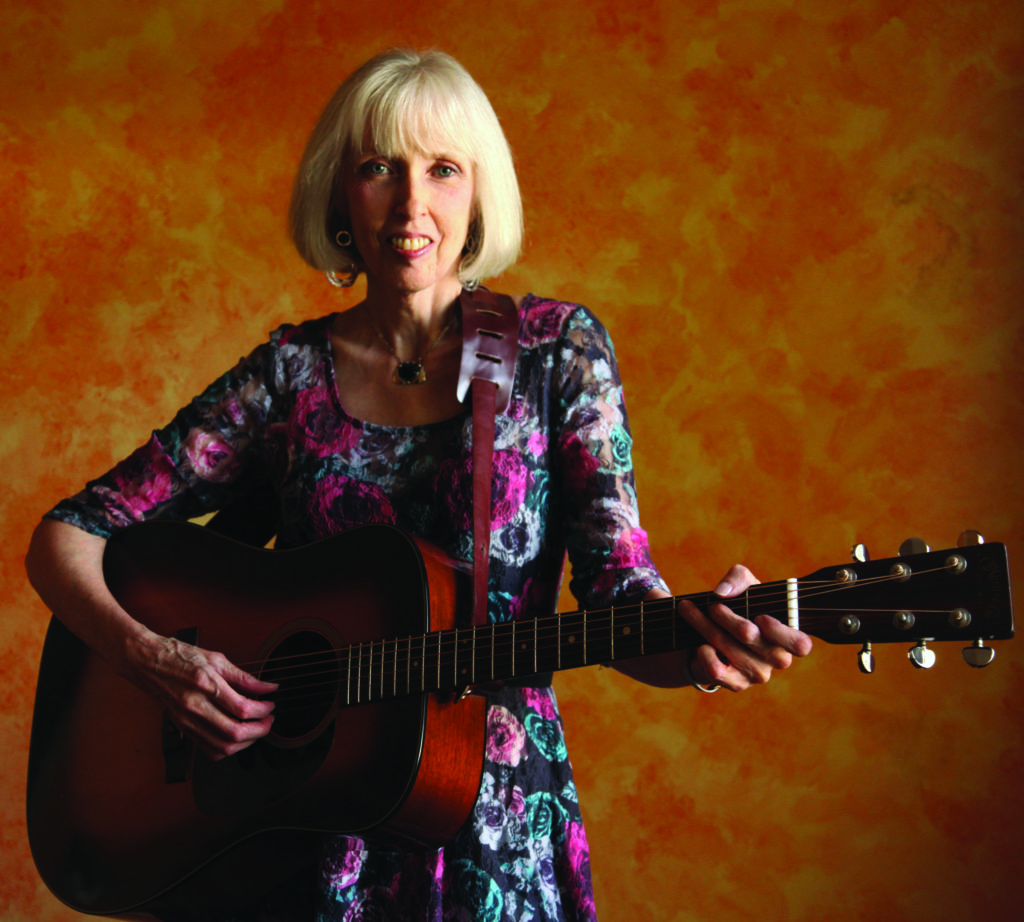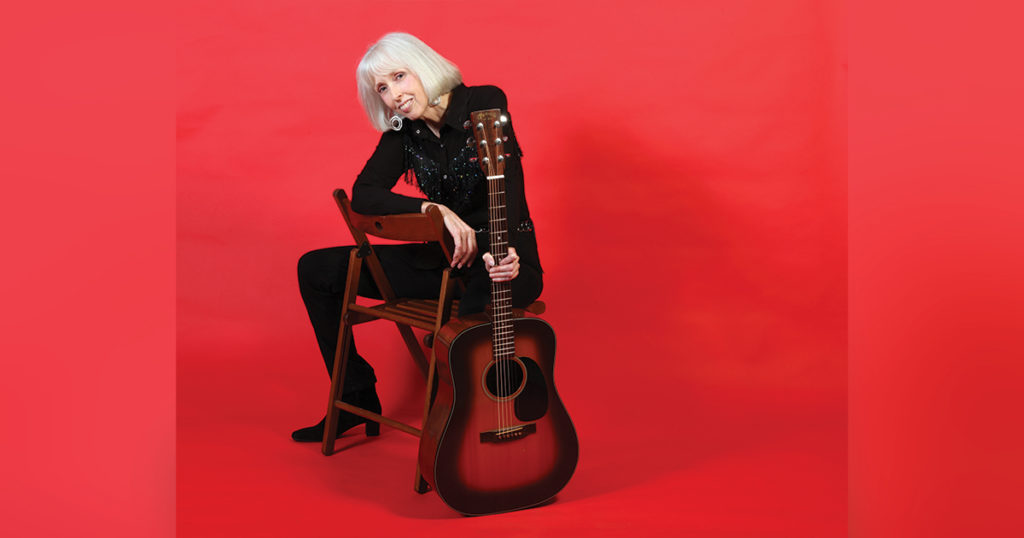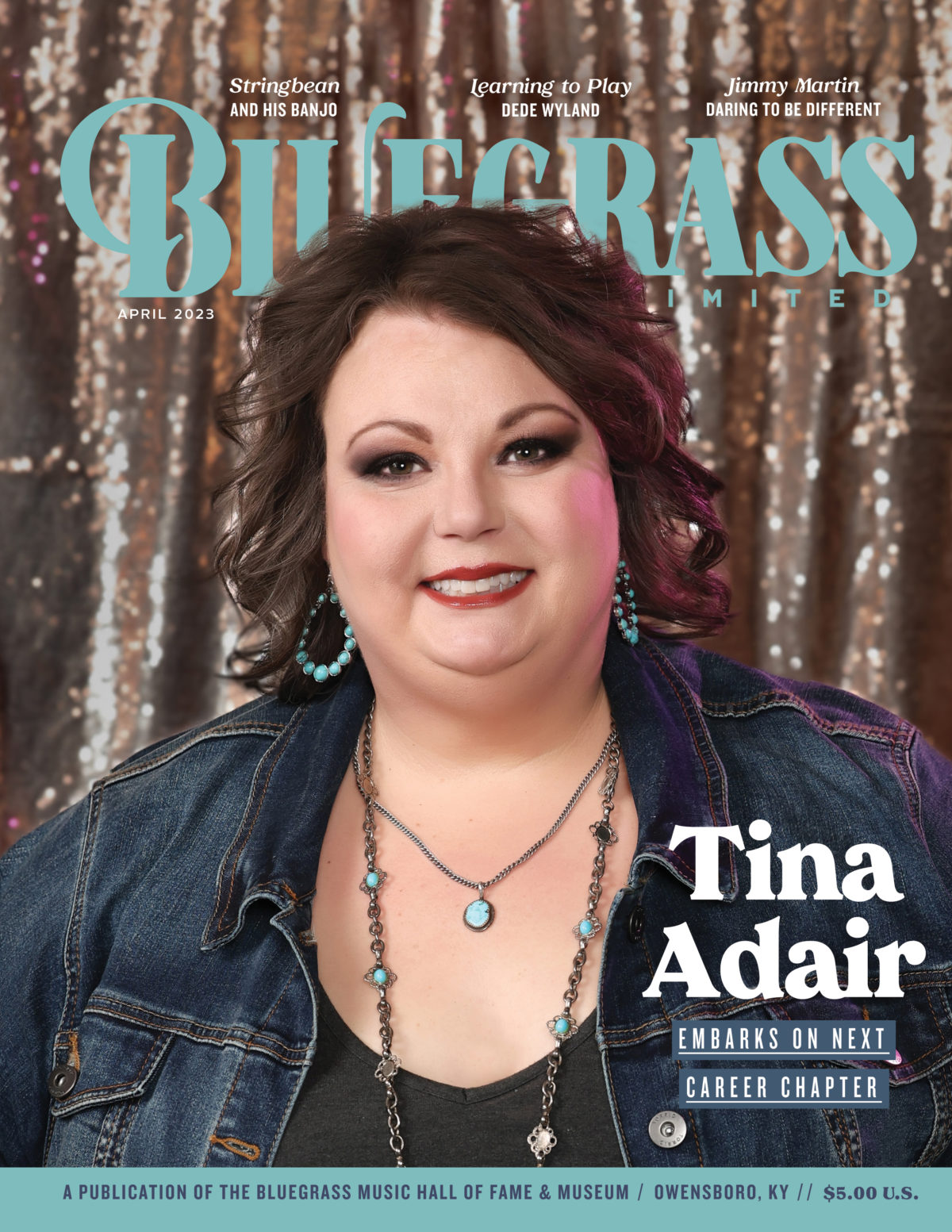Home > Articles > Learn To Play > Dede Wyland’s Online School of Voice
Dede Wyland’s Online School of Voice
Photos by Michael G. Stewart
Dede Wyland should be a familiar name to long-time Bluegrass Unlimited subscribers. The first mention of Dede in this magazine occurred in our December 1978 issue when her Wisconsin-based band Grass, Food & Lodging was featured. Five year’s later, after she had moved to New York, Dede was pictured on the cover of our October 1983 issue along with her Skyline bandmates Tony Trischka, Danny Weis, Barry Mitterhoff and Larry Cohen. Dede was next featured in an article that appeared in our January 2001 issue and most recently an article featuring Dede was published in our September 2020 issue.
Since the September 2020 feature was less than three years ago and did a great job of outlining Dede’s history in bluegrass and catching reader’s up with her career, I would like to focus this article on Dede’s talent as a singer and singing instructor. Ever since this “Learning To Play” column started nearly two years ago, we have highlighted instructional opportunities on every bluegrass instrument, except for the voice. It is about time we changed that. After all, the voice is an instrument and in bluegrass it is arguably the primary instrument.
Bluegrass singing, both lead and harmony, is one of the components that helps clearly define the genre. The “high lonesome sound” of Bill Monroe’s voice created a unique vocal tonality and the tight harmony parts that compete in volume with the lead singer make bluegrass harmonies stand out from other styles of music. Add to that the vocal phrasing of inhabitants of the southern mountains, which was evident in the vocal stylings of all first-generation bands, and you’ve defined a big part of the formula of bluegrass music.
Dede’s Vocal Journey
Dede Wyland, a native of Milwaukee, Wisconsin, started singing when she was in kindergarten. She said, “My kindergarten teacher noticed that I had a nice voice and so she soloed me in PTA meetings and things like that. So, I have always naturally gravitated towards singing. When I was thirteen, my best friend and I took guitar lessons together for a couple years and during that time my friend and I formed a living room band with my sister, Joy, and another friend on bass. This was my first band. I’ve always gravitated toward the band experience. I put music down in high school but then, inspired by the folk movement, picked it up again during my first year of college.”
Dede’s introduction to bluegrass music, and singing, first came when a Colorado band called The Monroe Doctrine performed at her college (this band appeared on the cover of BU in September of 1973 and featured Charles Sawtelle, Dick Schroeder, Wayne Beezley, Steve Carnes, and Kerry Craig). About that same time, Dede also attended the Philadelphia Folk Festival and heard Bill Monroe. She said, “Hearing The Monroe Doctrine and Bill Monroe that year just turned my head around. When I heard bluegrass music it was as if everything that I had ever done musically was waiting for that moment. It was so exciting, and I was passionate about it.”
When asked how she learned to sing bluegrass music, Dede said, “I was going to bluegrass festivals and listening. That is all that I did in the summer. I was taking my guitar and going out into the ‘field’ and playing, singing and jamming. That is the way I learned. I also did a lot of listening. That is what I think most people do who get good at what they do in bluegrass music…they go through a period where they are intensely listening to and absorbing the music. I certainly did that for years. You had the records and would sit next to the record player, pick the needle off the record and play one vocal lick over and over and learn it that way—intense listening and then learning from doing.”
When asked what qualities make bluegrass singing unique, Dede said, “It is very nuanced in its timing, phrasing and embellishments. There is also a difference in the way that the song is delivered emotionally. And these are things that you can only learn by listening and absorbing. When I was singing folk music, or the Beatles, prior to when bluegrass turned my head, I just would kind of sing the songs and didn’t delve too deeply. But when you feel passionate about something you listen more deeply and you start picking up the nuances, which has to do with vocal inflection, ornamentation, timing and tonality of the different sounds. You pick it up like a language and you do it just from listening.”
When asked who she primarily listened to when she was learning to develop a feel for the nuances of bluegrass singing, Dede said, “I think that my biggest influence was Ralph Stanley and the Clinch Mountain Boys. I didn’t listen to Bill Monroe that much. It was particularly Ralph Stanley and Keith Whitley. I was mesmerized by the nuance, ornamentation and the emotional quality of Keith Whitley’s singing. Carter Stanley was one of my favorites, too.” After thinking a moment, Dede continued, “Back then I was also listening to Vince Gill. He was only nineteen when I met him, but he already was, stylistically, doing some pretty cool things. I had the good fortune to meet him back when he was playing with Lonnie Pierce. I met him at a festival and we became friends and sang together. I started listening to him closely, so I would say that he is also an influence.”
Since harmony singing is such a big part of bluegrass, I asked Dede if she was already familiar with singing harmony prior to hearing bluegrass. She said, “I didn’t think about harmony too much before I learned about bluegrass music. But it wasn’t hard for me to learn it. I guess I was just lucky because I could hear harmony pretty easily. I also listened a lot and it was easy for me to understand the sensibility of a tenor part or a baritone part.”
When Dede first began singing bluegrass it was, in fact, the harmony parts that she was most comfortable singing. She did not blossom as a lead singer until her band Grass, Food Lodging went into the studio to record their first album. She said, “I never thought of myself as a lead singer and then with Grass, Food & Lodging it came time to do our first studio album. It became apparent, much to my surprise, that I was a strong lead singer. Before that, I was comfortable singing lead but didn’t yet see myself as a lead singer, so the album was a turning point.”
Thinking forward from that experience, Dede said, “I tell my students that you need to get comfortable with the idea that you are a singer. Embrace it. Accepting that helps to get them over a certain kind of hump in regards to confidence.” That statement inspired me to ask, “Do you find that there are people who don’t have that confidence because sometime in their life someone told them that they couldn’t sing?” Dede said, “Boy, I can’t tell you how many people I know, and students that I have had who have told me that. That is a really common, sad experience and it does a number on people. But the good news is that it’s something that can be turned around with some good vocal instruction.”
In order to help her students get over that hump, Dede explained, “Part of it is getting people familiar with their own voice. If you don’t sing a lot, or if you don’t feel that you are a good singer, you are not comfortable with the sound of your own voice and it makes you a little uptight. I encourage my students to expand the space around themselves. If we don’t give ourselves permission to sing, we are very tense and the sound stays within a tiny sphere around our bodies. We haven’t given ourselves permission to let go and open up. I try to help people to open up by encouraging them to make a variety of vocal sounds from very loud to very soft. Lots of people are quiet because they come from families that are quiet, or they are just naturally quiet so I try to slowly and carefully help them break down those barriers.”
Dede’s experience with taking singing lessons started when she was still singing folk music early in her college years. Later, after she had moved to New York City in the early 1980s, Dede also took voice lessons from a vocal instructor there. Regarding the lessons in college, and then later in New York City, Dede said, “I learned some things in those lessons, but I wasn’t able to solve some of the issues that I wanted to address. We mostly worked on some of my songs. I was singing okay back then, but I just didn’t know as much about it as I do now.
“It wasn’t until I decided I wanted to teach voice that I really started understanding how the voice works. There is important information that a voice teacher should teach to help their students more deeply understand how to use their voice, how to use the mechanism. I didn’t get that when I studied voice for myself. I got that when I studied how to teach voice.” Dede took a deep dive into understanding how to teach voice after she moved to the Washington, D.C. area in 1990 and studied the anatomy and physiology of the voice at the University of Maryland. Since finishing that program, she continues to go to workshops and conferences to keep up on the latest in vocal pedagogy and to hone her skills.
Teaching How To Sing

By learning how to teach others how to sing, Dede has not only learned how to identify and resolve problems and challenges that may arise in her own singing, but also has learned to identify and solve problems that others encounter. She said, “In studying to teach voice, I’ve learned what breath support really is…I’ve learned a whole different paradigm in terms of how to use the voice. I didn’t learn those things from my private teachers…or maybe I did and it wasn’t sinking in, or maybe they didn’t put it in terms that I could understand. In my teaching, I try to make it nice and clear. I usually start from scratch with everybody so that they can build a strong foundation and a solid understanding of how the voice works.”
Dede elaborates, “The voice is different than other instruments…it is definitely an instrument. It is a wind instrument. You have a valve and it has to do with air pressure and resonators. It is an instrument, but it is unique because it is in our body. Therefore, it makes more sense to really understand the apparatus that you are working with. “We understand vocal technique through sensory awareness. It has to do with what you are feeling in your body. If you have both the sensory awareness of the right feeling for singing and you are able to visualize the apparatus—the diaphragm, the wind pipe, the soft palate and those sort of things, you will be in the best position to learn.”
Regarding the aforementioned issue—students being too quiet and not opening up their voice—Dede said, “Part of helping people to get over their inhibitions is to get them to learn more about singing and technique. The more technique they learn, and the more they practice those techniques, the more confidence they start to build. That helps a lot.”
Because Dede was already a well-known and accomplished singer by the time she started really studying the mechanics, physiology and anatomy of singing, I asked, “When you started studying these things, did you have many ‘light-bulb’ moments when you thought, ‘I wish I had of known that twenty or thirty years ago!’” Dede responded, “Exactly! There were a lot of epiphanies. Like, ‘Why is it that I cannot extend that last note at the end of a phrase?’ Now I know exactly why. I know the mechanics behind it. Even though I was a ‘natural’ singer, I really didn’t understand a lot of things. In learning how to teach, I understood so much more and I could problem solve.”
In order to provide further explanation, Dede said, “Let’s look at a microcosm of what I’m talking about. So, let’s say I’m singing a song but there is one high note I can’t get. Why is it hard? As a teacher I know that it could be a number of things. It could be not enough lift in the soft pallet or not enough breath support or tension in the neck or jaw. It could be any one of a number of factors but now I know what the factors are, and I can check them one at a time and then solve the problem. In the end, learning these things made me more passionate about teaching.”
One of the things that Dede enjoys about teaching is observing the progress of her students. She said, my students occasionally have those ‘Oh, wow!’ moments because they realize they can make vocal sounds like they never made before, or they have never heard ‘that’ voice come out of them before. It can be quite exciting.”
Towards the close of our interview, Dede said, “There is one other point that I’d like to make about singing. When it comes to teaching singing, I feel that vocal technique bridges the gap between what we feel and what we can express. Good vocal technique is not an end in and of itself, it is the means through which we can freely and fully express ourselves vocally. Again, the objective is to learn the mechanics and ultimately, when singing, not THINK about them. Thinking is distracting and can interrupt the flow of natural expression. Ultimately, you want to get out of your own way, stop thinking, and just tell your story.
Online School of Voice
On her website (dedewyland.com) Dede offers a series of thirteen video lessons on a variety of topics that will enable a student to better understand the mechanics and anatomy and physiology of the voice. She also presents exercises that aid in gaining experiential understanding of these concepts. A student can choose to sign up for either a three-month or one-year period of online access to the material. The one-year rental costs $130. The three-month rental is $65. There are thirteen videos averaging about five minutes a piece.
During the course of the instruction the student will learn fine details about posture, breath, breath support, releasing tension, opening the throat, voice placement, projecting the voice, singing high notes, and vocal expression. In the future, Dede plans to continually add new material.
Private Lessons
In addition to offering the online videos, Dede is also available for private
lessons. She is happy to work with anyone privately in person or online and her students range from beginners to professional singers. When asked if she suggests that her students watch the video course prior to starting private lessons she said, “If I have the space, I’ll start working with them right away. I don’t require that they watch the videos. Sometimes the videos work better for some people’s budget. If that is the case, I’ll suggest that they watch the videos and work with them and then they can take a few lessons with me and I can help them with any questions that they might have.”
As her reputation for being an effective vocal teacher has grown over the years, Dede has found that professional singers will come up to her and ask questions about specific problems that they might be having with their voice. She said, “Everybody can use some help from time-to-time, no matter where you are. Some professionals have come to me and they were very worried because something is happening to their voices. I am connected to some really good vocal clinics and so I know the professionals that I can send them to in order to find out if there are any problems structurally. In some cases there were. If their voices are sound, I work with them and give them the technique they need to help deal with the problem. I always feel honored when I can help a person who is in that position.”
Producing and Performing
In addition to teaching voice, Dede also spends time these days producing local artists in the studio and performing with the band Big Howdy. She said, “We are a regional band because I don’t want to tour anymore.” Big Howdy is currently working on a new recording and performances have begun to pick up again after the slow down during the pandemic.
If you are new to bluegrass singing, or if you have been singing for a while and feel that you want to overcome some issue, or if you are a professional singer who is experiencing voice fatigue or having some other vocal issue, navigate to dedewyland.com and shoot Dede an email. She will be happy to help.

